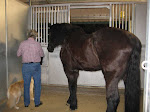When I first got Doc he was a yearling who hung around humans and went with them when on a lead rope because he wanted to. He was not truly halter-broken and I was betting he wasn’t trained to stand tied either. I had a lot of experience with these problems by the time I acquired my big, black horse. And it was a darn good thing too!
The first time I ran afoul of the problem of an animal not being trained to wear a halter or collar was when I was about six years old and my grandfather gave me a puppy. If you want to know what it looked like look at the picture of Sassy. Incidentally, Sass is a descendent of the dogs my grandfather bred.
My grandmother named him Tripper because he would run between her legs and cause her to trip. Now, at sixty myself, I have a LOT more sympathy and understanding for the problem.
Putting a collar on Tripper was easy enough. He pitched a fit about wearing it, but eventually settled down and carried it. The real problem began when I tried to put a leash on him. He pitched a fit and alternately either was at the end trying to run away or laying down being dragged. I think my mother was the one who eventually taught him to lead, sort of. Tripper was never an ideal dog, but he sure taught me a lot of important things about animals.
My education with teaching animals to lead continued when we were at the farm of one of my mother’s cousins and there was a new foal. It was by a stallion named Yellow Jacket, something I didn’t appreciate until many years later, just as I didn’t recognize the significance of Joe Hancock as the sire of the old stallion another relative kept. For those of you not familiar with Quarter Horses these are some early stallions that contributed to the breed in a major fashion.
I was out in the pen with the mare and foal. Being a kid I found a bit of rope and managed to get it around the foal’s neck. The foal got away from me and wouldn’t let me near it again. Finally, afraid the foal would hurt itself with that noose around its neck; I went into the house and confessed what I’d done. The cousin who owned the mare went out and removed the loop. Then he told me, “It’s best not to mess with other people’s animals if you don’t know what you are doing.”
Sometimes I wish I’d taken that bit of advice to heart, but I didn’t.
I continued messing with other people’s horses every chance I got.
It may help you to understand when I tell you I was the kind of kid who, after watching her first episode of Superman, got a towel, tied it around my neck, climbed on the garage roof and jumped off. For most of my life that is how I’ve done things. Watch someone do it, then go out and try to do it myself.
Really now that I think about it this isn’t too far off the mantra of how to make a surgeon. Show one. Do one. Teach one. I will say though you end up with a lot more injuries when this is the way you learn to train horses and dogs.
As for Doc it was a good thing I had learned my lessons well by the time he came into my life because, as big as he was, I needed every thing I’d ever learned to turn him into a well-mannered horse.
Lazy Trainers Tip
To learn to train an animal find a professional you are comfortable with and learn how they do it. Then try it yourself. After that—teach someone else how to do it.
Subscribe to:
Post Comments (Atom)










No comments:
Post a Comment